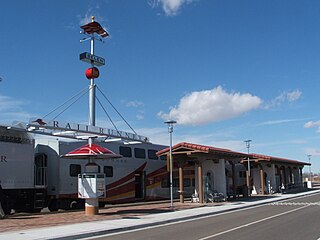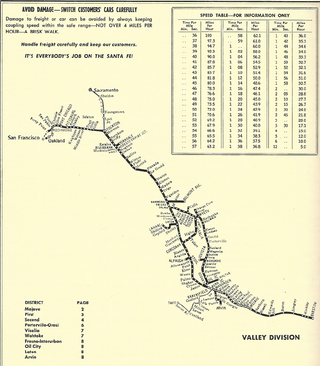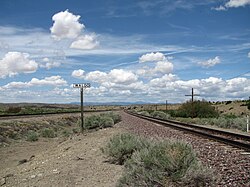
The Atchison, Topeka and Santa Fe Railway, often referred to as the Santa Fe or AT&SF, was one of the largest Class 1 railroads in the United States between 1859 and 1996.

The Kansas City, Mexico and Orient Railway, started in 1900 by American railroad entrepreneur Arthur Edward Stilwell, was the predecessor of the Chihuahua al Pacífico railroad in Mexico. It was intended to reach the Pacific Ocean at Topolobampo, Sinaloa.

The Santa Fe, Prescott and Phoenix Railway (SFP&P) was a common carrier railroad that later became an operating subsidiary of the Atchison, Topeka and Santa Fe Railway in Arizona. At Ash Fork, Arizona, the SFP&P connected with Santa Fe's operating subsidiary, the Atlantic & Pacific Railroad mainline, that ran from California to Chicago. The SFP&P's 195-mile (314 km) line extended the Santa Fe Railway south into Phoenix. The SFP&P extended another 100 miles (160 km) to the east from Phoenix to Florence and Winkelman via the Phoenix and Eastern Railroad. The SFP&P also served several mines in the Prescott area, including the Derby Mine by way of the Summit (flag) Station at 'Prieta' in the Sierra Prieta range, through its various subsidiary railroads.
The Santa Fe and Grand Canyon Railroad (SF&GC) was a 56-mile railroad that ran from Williams, Arizona to take mining supplies and people to the copper mines near Anita. In 1901, the SF&GC was sold at foreclosure and became the Grand Canyon Railway, a subsidiary of the Atchison, Topeka and Santa Fe Railway. Today the line is a heritage railway owned by the Grand Canyon Railway providing excursions to the Grand Canyon.

Belen is the southern terminus of the New Mexico Rail Runner Express commuter rail line, located in the center of the town of Belen, New Mexico, near the intersection of Reinken Avenue and Wisconsin Street. It serves residents of Belen and surrounding communities in Valencia County, New Mexico. The station began service on February 2, 2007, as the fifth station on the line.

Lamy station is an Amtrak station at Santa Fe County Road 33, 152 Old Lamy Trail in Lamy, New Mexico, United States. It is served by the Southwest Chief. It is also the southern terminus for the Sky Railway. The station was built in 1909 by the Atchison, Topeka and Santa Fe Railway.

The San Bernardino Santa Fe Depot is a Mission Revival Style passenger rail terminal in San Bernardino, California, United States. It has been the primary station for the city, serving Amtrak today, and the Santa Fe and Union Pacific Railroads in the past. Until the mid-20th century, the Southern Pacific Railroad had a station 3/4 of a mile away. It currently serves one Amtrak and two Metrolink lines. The depot is a historical landmark listed on the National Register of Historic Places as Atchison, Topeka and Santa Fe Railway Passenger and Freight Depot.

Santa Fe Depot is the northern terminus of the New Mexico Rail Runner Express commuter rail line. The station was originally built by the Atchison, Topeka and Santa Fe, and until 2014 served as the northern terminus, offices, and gift shop of the Santa Fe Southern Railway, a tourist and freight carrying short line railroad. It is located in Santa Fe, New Mexico at 410 Guadalupe Street, within an area of urban renewal referred to as the "Railyard". Rail Runner service to the station began on December 17, 2008.

The Southern Transcon is a main line of the BNSF Railway comprising 11 subdivisions between Southern California and Chicago, Illinois. Completed in its current alignment in 1908 by the Atchison, Topeka and Santa Fe Railway, when it opened the Belen Cutoff in New Mexico and bypassed the steep grades of Raton Pass, it now serves as a mostly double-tracked intermodal corridor.

The West Texas & Lubbock Railway is a shortline railroad in Texas, owned by Watco. It connects the BNSF in Lubbock with agricultural and oil-producing areas to the west and southwest. The company operates 107 miles of two ex-Atchison, Topeka & Santa Fe Railway lines, extending to Whiteface and Seagraves parallel to State Highway 114 and U.S. Highway 62. The primary commodities hauled are fertilizer, construction aggregates, grain, cotton, chemicals, peanuts and plastics.
The Chili Line, officially known as the Santa Fe Branch, was a 3 ft narrow-gauge branch of the Denver and Rio Grande Western Railroad (D&RGW). It ran 125.6 miles (202.1 km) from Antonito, Colorado, to Santa Fe, New Mexico. The Denver and Rio Grande Railway (D&RG) began construction of the line in 1880 and completed the line from Antonito to Española, New Mexico, but could not build any further because of an agreement with the Atchison, Topeka and Santa Fe Railroad (AT&SF). The Texas, Santa Fe and Northern Railroad was incorporated to complete the line, and the line between Española and Santa Fe opened in 1886 and was transferred to the Denver and Rio Grande shortly thereafter. The D&RGW closed the Chili Line in 1941 because of competition from road transportation, and the line was abandoned shortly thereafter.

The Escondido Sub is a 22-mile (35 km) branch railway line between Oceanside, California and Escondido, California, in the North County region of San Diego County. It is primarily used today by the Sprinter hybrid rail and local freight trains serving Escondido industries late at night, after the last Sprinter train of the day is taken out of service.

The Fort Worth and Rio Grande Railway, chartered under the laws of Texas on June 1, 1885, was part of a plan conceived by Buckley Burton Paddock and other Fort Worth civic leaders to create a transcontinental route linking New York, Fort Worth, and the Pacific port of Topolobampo, which they believed would stimulate the growth and development of southwest Texas in general, and the economy of Fort Worth in particular.

The Alamosa–Durango line or San Juan extension was a railroad line built by the Denver and Rio Grande Western Railroad, following the border between the U.S. states of Colorado and New Mexico, in the Rocky Mountains. The line was originally built as a 3 ft narrow-gauge line between Alamosa, Colorado, and Durango, Colorado. Portions of the route survive: the now standard-gauged segment from Alamosa to Antonito, Colorado, and a narrow-gauge portion from Antonito to Chama, New Mexico.

Nutt is an unincorporated community in Luna County, southern New Mexico, in the American Southwest. It is located nineteen miles southwest of Hatch on NM 26 at the intersection with NM 27.

Milo is a ghost town in Lincoln County, Kansas, United States. It was located along a former railroad about halfway between the communities of Barnard and Ada.

The Valley Division of the Atchison, Topeka and Santa Fe Railway ran from San Francisco to Barstow in California. It is currently in operation as the BNSF Railway's Stockton Subdivision and Bakersfield Subdivision.

Atchison, Topeka and Santa Fe No. 769 is a preserved 769 class 2-8-0 "consolidation" type steam locomotive originally built by the Richmond Locomotive Works in 1900 as one of the Santa Fe Pacific Railroad's final locomotives. It was originally numbered 266 before the SFP had completely merged into its parent company, the Atchison, Topeka and Santa Fe Railway, and the locomotive was renumbered 3045, and it was eventually renumbered again to 769. The locomotive was put into use for short-distance freight trains and for yard switching before being sold again in 1950 to the Albuquerque and Cerrillos Coal Company in Madrid, New Mexico for more yard switching and short distance coal trains. As the 1950s progressed, however, the company shut down due to bankruptcy, and No. 769 was abandoned along with the rest of the locomotive yard and the rest of Madrid. In the late 1970s the town was recovered and converted into a heritage town, and No. 769 was then put on static display just behind the shed it was stored in, which was converted to the Engine House Theatre. In early 2020, No. 769 was selected for a future project to restore it to operating condition to eventually run on reconstructed trackage between Madrid and a nearby BNSF interchange near Los Cerrillos.
The New Mexico Central Railroad was formed in 1908 from the consolidation of the Santa Fe Central Railway and the Albuquerque Eastern Railway Co., to operate the 116 miles of track between Torrance and Santa Fe, New Mexico. That line, reorganized in 1918 as the New Mexico Central Railway, was sold to the Atchison, Topeka and Santa Fe Railroad in 1926. The New Mexico Central remained the nominal owner of the Santa Fe-leased line while the Santa Fe proceeded to abandon operation of the trackage in pieces, ending in 1972 with abandonment from Willard to Calvert (Moriarty), New Mexico.


















